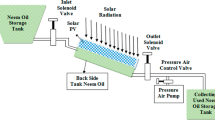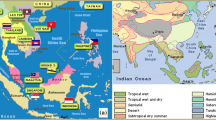Abstract
In hot and humid areas with high solar radiation intensity, the use of air conditioning systems on the basis of desiccant materials such as solar desiccant cooling systems with a view to reducing energy consumption and economic saving can be a good alternative to conventional air conditioning units. In this paper, in order to offer a cooling load of a sample space in the city of Bandar Abbas, which has a high latent load and high radiation intensity, solar absorption cooling cycle has been considered as the base cycle, and two absorption cooling cycles were designed for comparison. Then the three cycles were modeled in the TRNSYS software, studied technically and economically, and at the end the best cycle has been selected. In terms of current energy prices, application of solar energy in Iran is not economically feasible, so the solar absorption refrigeration cycle has been considered as the basic system for the cycle’s comparison. Modeling of the expressed cycles was done in TRNSYS software. The basic cycle has been composed of two main parts of cooling by absorption chillers and providing the required heat supply by the solar collector, and also two desiccant dehumidification cycles have been added by a desiccant dehumidification system. In the economic analysis of the three systems, the costs estimation during lifetime (LCC) method also has been used. As a result of this modeling and due to the Act to amend energy prices, the cooling system with the help of desiccant wheel and using returned water of chiller’s generator as the regeneration source, with an annual energy saving of about 29.1%, 29.1% (1,371,980 m3) of natural gas consumption has been saved and the amount of 18/15% (156,667$) cost savings over 20 years compared to the base period, has been selected as the most efficient cooling system.







Similar content being viewed by others
Abbreviations
- \( \dot{Q} \) :
-
Heat transfer rate
- T :
-
Temperature
- \( \dot{m} \) :
-
Mass flow rate
- h :
-
Sensible enthalpy
- \( \tau \alpha \) :
-
Coefficient represents the effect of the pass
- U L :
-
Overall heat loss coefficient
- C p :
-
Specific heat capacity at constant pressure
- I :
-
Solar radiation intensity
- A :
-
Surface area
- w :
-
Humidity ratio
- Capacity:
-
Cooling capacity of the chiller
- \( \bar{T} \) :
-
The average air temperature
- C min :
-
Minimum capacity
- f FullLoadCapacity :
-
Fraction of the nominal load generated by the chiller
- f NominalCapacity :
-
A fraction of the full load capacity
- C s :
-
Initial cost
- C A :
-
Price per square meter of collector area
- C v :
-
Price per cubic meter of storage tank
- V s :
-
Volume of tank
- C aux :
-
The cost of fuel in auxiliary heater
- C g :
-
Price per cubic meter of natural gas
- L v :
-
Thermal value of natural gas
- Q aux :
-
Energy from fuel
References
Lucas L. Iir news. Int J Refrig. 1998;21(2):87–8.
Jaber JO, Badran OO, Abu-Shikhah N. Sustainable energy and environmental impact: role of renewables as clean and secure source of energy for the 21st century in Jordan. Clean Technol Environ Policy. 2004;6(3):174–86.
Florides GA, Kalogirou SA, Tassou SA, Wrobel LC. Modeling, simulation and warming impact assessment of a domestic-size absorption solar cooling system. Appl Therm Eng. 2002;22(12):1313–25.
Daou K, Wang R, Xia Z. Desiccant cooling air conditioning: a review. Renew Sustain Energy Rev. 2006;10(2):55–77.
Farshad SA, Sheikholeslami M. Nanofluid flow inside a solar collector utilizing twisted tape considering exergy and entropy analysis. Renew Energy. 2019;141:246–58.
Sheikholeslami M, Gerdroodbary MB, Shafee A, Tlili I. Hybrid nanoparticles dispersion into water inside a porous wavy tank involving magnetic force. J Therm Anal Calorim. 2019. https://doi.org/10.1007/s10973-019-08858-6.
Szilágyi IM, Kállay-Menyhárd A, Šulcová P, Kristóf J, Pielichowski K, Šimon P. Recent advances in thermal analysis and calorimetry presented at the 1st journal of thermal analysis and calorimetry conference and 6th V4 (Joint Czech-Hungarian-Polish-Slovakian) thermoanalytical conference (2017). J Therm Anal Calorim. 2018;133:1–4.
Yang L, Ji W, Zhang Z, Jin X. Thermal conductivity enhancement of water by adding graphene nano-sheets: consideration of particle loading and temperature effects. Int Commun Heat Mass Transf. 2019;109:104353.
Sheikholeslami M, Sheremet MA, Shafee A, Li Z. CVFEM approach for EHD flow of nanofluid through porous medium within a wavy chamber under the impacts of radiation and moving walls. J Therm Anal Calorim. 2019. https://doi.org/10.1007/s10973-019-08235-3.
Sheikholeslami M, Arabkoohsar A, Jafaryar M. Impact of a helical-twisting device on nanofluid thermal hydraulic performance of a tube. J Therm Anal Calorim. 2019. https://doi.org/10.1007/s10973-019-08683-x.
Sheikholeslami M. New computational approach for exergy and entropy analysis of nanofluid under the impact of Lorentz force through a porous media. Comput Methods Appl Mech Eng. 2019;344:319–33.
Sheikholeslami M, Haq R-U, Shafee A, Li Z, Elaraki YG, Tlili I. Heat transfer simulation of heat storage unit with nanoparticles and fins through a heat exchanger. Int J Heat Mass Transf. 2019;135:470–8.
Sheikholeslami M, Haq RU, Shafee A, Li Z. Heat transfer behavior of nanoparticle enhanced PCM solidification through an enclosure with V shaped fins. Int J Heat Mass Transf. 2019;130(2019):1322–42.
Qin Y. A review on the development of cool pavements to mitigate urban heat island effect. Renew Sustain Energy Rev. 2015;52:445–59.
Sheikholeslami M, Shehzad SA, Li Z, Shafee A. Numerical modeling for alumina nanofluid magnetohydrodynamic convective heat transfer in a permeable medium using Darcy law. Int J Heat Mass Transf. 2018;127:614–22.
Qin Y, He Y, Hiller JE, Mei G. A new water-retaining paver block for reducing runoff and cooling pavement. J Clean Prod. 2018;199:948–56.
Sheikholeslami M, Ghasemi A, Li Z, Shafee A, Saleem S. Influence of CuO nanoparticles on heat transfer behavior of PCM in solidification process considering radiative source term. Int J Heat Mass Transf. 2018;126:1252–64.
Qin Y, Luo J, Chen Z, Mei G, Yan L-E. Measuring the albedo of limited-extent targets without the aid of known-albedo masks. Sol Energy. 2018;171:971–6.
Qin Y, Liang J, Luo Z, Tan K, Zhu Z. Increasing the southern side-slope albedo remedies thermal asymmetry of cold-region roadway embankments. Cold Reg Sci Technol. 2016;123:115–20.
Fong KF, Chow TT, Lee CK, Lin Z, Chan LS. Comparative study of different solar cooling systems for buildings in subtropical city. Sol Energy. 2010;84(2):227–44.
Gebreslassie BH, Guillén-Gosálbez G, Jiménez L, Boer D. Solar assisted absorption cooling cycles for reduction of global warming: a multi-objective optimization approach. Solar Energy. 2012;86:2083–94.
Henning H-M, Erpenbeck T, Hindenburg C, Santamaria IS. The potential of solar energy use in desiccant cooling cycles. Int J Refrig. 2001;24:220–9.
Daou K, Wang RZ, Xia ZZ. Desiccant cooling air conditioning: a review. Renew Sustain Energy Rev. 2006;10:55–77.
Krishna S, Murthy SS. Experiments on silica gel rotary dehumidifier. Heat Recovery Syst CHP. 1989;9(467–473):1989.
Vineyard EA, Sand JR, Durfee DJ. Performance characteristics for a desiccant system at two extreme ambient conditions. ASHRAE Trans. 2002;108:587–96.
Sheikholeslami M, Darzi M, Li Z. Experimental investigation for entropy generation and exergy loss of nano-refrigerant condensation process. Int J Heat Mass Transf. 2018;125:1087–95.
Sheikholeslami M, Ghasemi A. Solidification heat transfer of nanofluid in existence of thermal radiation by means of FEM. Int J Heat Mass Transf. 2018;123:418–31.
Qin Y, Zhao Y, Chen X, Wang L, Li F, Bao T. Moist curing increases the solar reflectance of concrete. Constr Build Mater. 2019;215:114–8.
Sheikholeslami M, Shehzad SA. CVFEM simulation for nanofluid migration in a porous medium using Darcy model. Int J Heat Mass Transf. 2018;122:1264–71.
Sheikholeslami M, Shehzad SA. Simulation of water based nanofluid convective flow inside a porous enclosure via non-equilibrium model. Int J Heat Mass Transf. 2018;120:1200–12.
Qin Y, He H, Ou X, Bao T. Experimental study on darkening water-rich mud tailings for accelerating desiccation. J Clean Prod. 2019. https://doi.org/10.1016/j.jclepro.2019.118235.
Sheikholeslami M. Numerical approach for MHD Al2O3-water nanofluid transportation inside a permeable medium using innovative computer method. Comput Methods Appl Mech Eng. 2019;344:306–18.
Sheikholeslami M, Seyednezhad M. Simulation of nanofluid flow and natural convection in a porous media under the influence of electric field using CVFEM. Int J Heat Mass Transf. 2018;120:772–81.
Sheikholeslami M, Rokni HB. Numerical simulation for impact of Coulomb force on nanofluid heat transfer in a porous enclosure in presence of thermal radiation. Int J Heat Mass Transf. 2018;118:823–31.
Yang L, Mao M, Huang JN, Ji W. Enhancing the thermal conductivity of SAE 50 engine oil by adding zinc oxide nano-powder: an experimental study. Powder Technol. 2019;356:335–41.
Sheikholeslami M, Bhatti MM. Active method for nanofluid heat transfer enhancement by means of EHD. Int J Heat Mass Transf. 2017;109:115–22.
Yang L, Ji W, Huang JN, Xu G. An updated review on the influential parameters on thermal conductivity of nano-fluids. J Mol Liq. 2019;296:111780.
Sheikholeslami M, Ellahi R. Three dimensional mesoscopic simulation of magnetic field effect on natural convection of nanofluid. Int J Heat Mass Transf. 2015;89:799–808.
Yang L, Xu J, Du K, Zhang X. Recent developments on viscosity and thermal conductivity of nanofluids. Powder Technol. 2017;317:348–69.
Sheikholeslami M. Magnetic field influence on CuO–H2O nanofluid convective flow in a permeable cavity considering various shapes for nanoparticles. Int J Hydrog Energy. 2017;42:19611–21.
Vo DD, Hedayat M, Ambreen T, Shehzad SA, Sheikholeslami M, Shafee A, Nguyen TK. Effectiveness of various shapes of Al2O3 nanoparticles on the MHD convective heat transportation in porous medium: CVFEM modeling. J Therm Anal Calorim. 2019. https://doi.org/10.1007/s10973-019-08501-4.
Yang L, Du K. A comprehensive review on the natural, forced and mixed convection of non-Newtonian fluids (nanofluids) inside different cavities. J Therm Anal Calorim. 2019. https://doi.org/10.1007/s10973-019-08987-y.
Sharaf MA, Nafey AS, García-Rodríguez L. Exergy and thermo-economic analyses of a combined solar organic cycle with multi effect distillation (MED) desalination process. Desalination. 2011;272:135–47.
Montes MJ, Abánades A, Martínez-Val JM, Valdés M. Solar multiple optimization for a solar-only thermal power plant, using oil as heat transfer fluid in the parabolic trough collectors. Sol. Energy. 2009;83:2165–76.
Author information
Authors and Affiliations
Corresponding author
Additional information
Publisher's Note
Springer Nature remains neutral with regard to jurisdictional claims in published maps and institutional affiliations.
Rights and permissions
About this article
Cite this article
Sani, A.L., Ayani, M., Behbahani-Nia, S.A. et al. Presentation of new approach for energy consumption reduction with use of solar system. J Therm Anal Calorim 143, 705–714 (2021). https://doi.org/10.1007/s10973-019-09252-y
Received:
Accepted:
Published:
Issue Date:
DOI: https://doi.org/10.1007/s10973-019-09252-y




